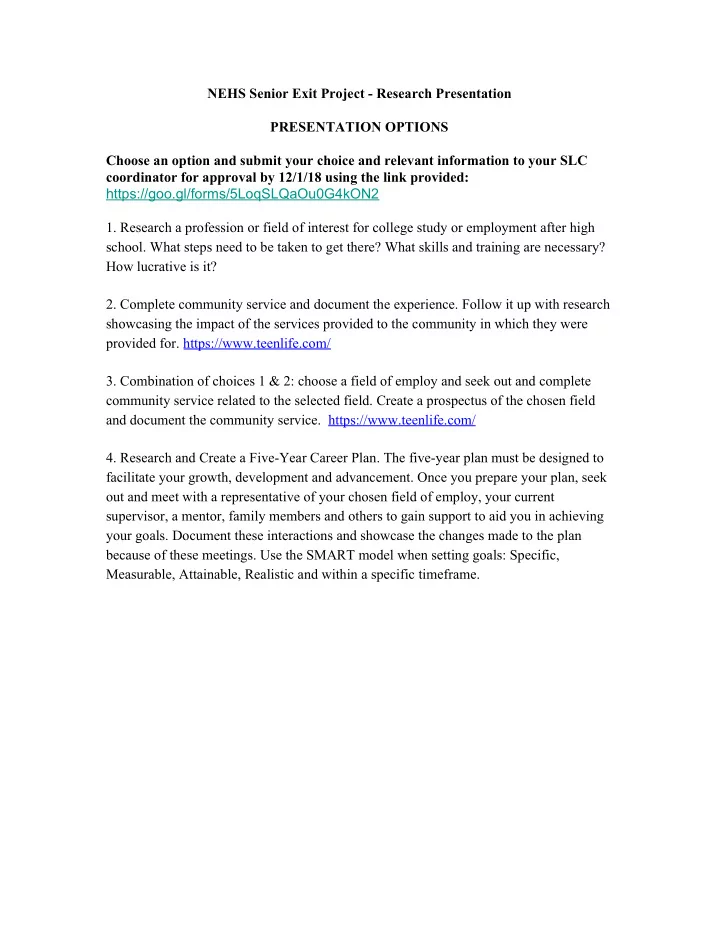

NEHS Senior Exit Project - Research Presentation PRESENTATION OPTIONS Choose an option and submit your choice and relevant information to your SLC coordinator for approval by 12/1/18 using the link provided: https://goo.gl/forms/5LoqSLQaOu0G4kON2 1. Research a profession or field of interest for college study or employment after high school. What steps need to be taken to get there? What skills and training are necessary? How lucrative is it? 2. Complete community service and document the experience. Follow it up with research showcasing the impact of the services provided to the community in which they were provided for. https://www.teenlife.com/ 3. Combination of choices 1 & 2: choose a field of employ and seek out and complete community service related to the selected field. Create a prospectus of the chosen field and document the community service. https://www.teenlife.com/ 4. Research and Create a Five-Year Career Plan. The five-year plan must be designed to facilitate your growth, development and advancement. Once you prepare your plan, seek out and meet with a representative of your chosen field of employ, your current supervisor, a mentor, family members and others to gain support to aid you in achieving your goals. Document these interactions and showcase the changes made to the plan because of these meetings. Use the SMART model when setting goals: Specific, Measurable, Attainable, Realistic and within a specific timeframe. 1.
COMPONENTS TO INCLUDE Introduction - inform your audience of type of project you selected and the project’s topic. Each bullet point should be a concise summary of what you will tell the audience verbally throughout the duration of the presentation. Background - a brief overview for your audience to provide information for them to fully understand what your what you will present. Define any uncommon language, locations, or ideas at this point. Research Question or Questions - state your research questions – each question should stand alone on a single slide. The goal is to showcase the questions you will answer by the end of the presentation, based on your research. Research Methods - share with your audience how you went about collecting and analyzing your data. Did you do community service, Internet research, interviews, etc… Findings/Data - clearly organize and display your data and findings. This is where graphs, charts and images are most helpful. Let the data do the talking in this section and just explain the graphs, charts and images you are presenting to your audience. Discussion/Conclusions Reached - analyze and discuss the answers you obtained from the data you showed on the previous slides. This is a concise summary of your main findings. Ideally, you should be able to answer the research questions you initially posed in the beginning. References - include 6 - 8 key references. Be sure your references are in the proper format (APA or MLA) for your field of study. Acknowledgements - thank the people, programs and any other outside sources that allowed you to perform your research, and anyone else you may want to add! Questions - include a final slide that simply says “Questions?” or “Any Questions?” in the center of the slide. If you DO NOT know the answer to a question it is always a bad idea to “fake” an answer to a question. Instead, say something like: “I actually don’t know the answer to that, but it’s a great question and I will look into it.” Follow-up with this person after your presentation so you can send them information on what you discover.
SLIDE DESIGN 1. 1 message per slide - just like a paragraph in a paper, slides should only contain a single idea. 2. 6 objects of less per slide – think keywords, numbers, images, or charts/graphs. There should not be paragraphs on any slide, ever. 3. No nonessential (unnecessary) items on the slide – if it doesn’t connect to the message for that slide, get rid of it. 4. Images should be colorful and REAL – avoid using clipart (aka, cheesy cartoons); visuals should add to what you’re saying, not detract. 5. Use effects sparingly – don’t have loud, obnoxious sound effects and text flying in from everywhere. This is a presentation, not a circus. 6. Your ending should be just as awesome as your beginning . After you finish with your conclusion and asking if the audience has questions, what’s an interesting way to wrap things up? Think, BIG BANG. This could include anything from relevant exit music, rapid-fire slides of significant images, or a moral or lesson you want to impart to the audience. Be creative in order to be memorable. PRESENTATION 1. Start black – begin with the screen black. Introduce yourself first, then the slides. 2. Introduction = Amazing! Just like the hook of an essay—draw your audience in. 3. YOU are the presenter – Be storytellers, not story readers. Rehearse your presentation so you rely very little on the notes. This is a non-negotiable! 4. Use your body to make points, not a pointer! Body language counts for over 70% of communication. 5. Clip your videos – if you include videos, please don’t show any part that is not necessary. A FEW FINAL WORDS… 5 to 7 minutes is the goal, and that’s only if the topic is presented in an interesting way. Anything more or less will indicate a failure to rehearse and plan, and will negatively affect your grade. Move quickly through your slides. Don’t linger. The best way to avoid lingering is to have an abundance of slides . This doesn’t mean make random stuff up, rather spread your information across many slides versus packing a few slides very full . The audience will be compelled to listen to what you say to connect to the slides you’re showing.
Recommend
More recommend